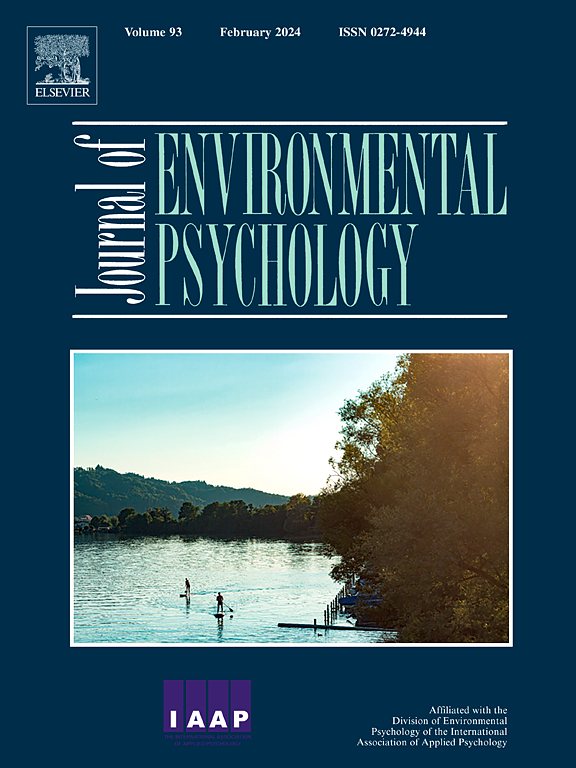A review of the effectiveness of metrics for assessing human responses to biophilic environments involving views, shading, and interior design elements
IF 7
1区 心理学
Q1 ENVIRONMENTAL STUDIES
引用次数: 0
Abstract
The characterization of biophilic environments, recognized for their potential to enhance well-being, requires researchers to have access to relevant metrics and methodologies when it comes to assessing this potential. Given the large diversity of well-being measures and experimental protocols used in existing studies, this review aims to critically evaluate the effectiveness of well-being metrics and measures that have been proposed or investigated in the literature with a focus on views, shading, and interior design elements. These include subjective, physiological, and cognitive metrics, as well as a diversity of experimental protocols used in studies on biophilic interventions indoors. The review analyzes the distribution of selected experimental stimuli, context, environment, and setup, with special attention given to identifying and analyzing metrics associated with well-being outcomes that demonstrated statistical significance. Additionally, this paper highlights the underreported aspect of effect size, which is systematically compiled and presented here. The purpose of this review is to provide a comprehensive understanding of the metrics used in the biophilic environment research of indoor spaces so far and to offer a grounded framework for future studies aiming to evaluate the impact of biophilic interventions on occupant well-being.
评估人类对亲生物环境反应的有效性指标,包括景观、遮阳和室内设计元素
亲生物环境的特征被认为具有提高福祉的潜力,这就要求研究人员在评估这种潜力时能够获得相关的指标和方法。鉴于现有研究中使用的幸福指标和实验方案的多样性,本综述旨在批判性地评估文献中提出或研究的幸福指标和措施的有效性,重点关注景观、遮阳和室内设计元素。这些指标包括主观、生理和认知指标,以及在室内亲生物干预研究中使用的各种实验方案。本综述分析了选定的实验刺激、背景、环境和设置的分布,特别注意识别和分析与幸福感结果相关的指标,这些指标具有统计意义。此外,本文强调了效应大小未被报道的方面,这是系统地汇编和呈现在这里。本综述的目的是全面了解迄今为止室内空间亲生物环境研究中使用的指标,并为旨在评估亲生物干预对居住者福祉的影响的未来研究提供一个基础框架。
本文章由计算机程序翻译,如有差异,请以英文原文为准。
求助全文
约1分钟内获得全文
求助全文
来源期刊

Journal of Environmental Psychology
Multiple-
CiteScore
10.60
自引率
8.70%
发文量
140
审稿时长
62 days
期刊介绍:
The Journal of Environmental Psychology is the premier journal in the field, serving individuals in a wide range of disciplines who have an interest in the scientific study of the transactions and interrelationships between people and their surroundings (including built, social, natural and virtual environments, the use and abuse of nature and natural resources, and sustainability-related behavior). The journal publishes internationally contributed empirical studies and reviews of research on these topics that advance new insights. As an important forum for the field, the journal publishes some of the most influential papers in the discipline that reflect the scientific development of environmental psychology. Contributions on theoretical, methodological, and practical aspects of all human-environment interactions are welcome, along with innovative or interdisciplinary approaches that have a psychological emphasis. Research areas include: •Psychological and behavioral aspects of people and nature •Cognitive mapping, spatial cognition and wayfinding •Ecological consequences of human actions •Theories of place, place attachment, and place identity •Environmental risks and hazards: perception, behavior, and management •Perception and evaluation of buildings and natural landscapes •Effects of physical and natural settings on human cognition and health •Theories of proenvironmental behavior, norms, attitudes, and personality •Psychology of sustainability and climate change •Psychological aspects of resource management and crises •Social use of space: crowding, privacy, territoriality, personal space •Design of, and experiences related to, the physical aspects of workplaces, schools, residences, public buildings and public space
 求助内容:
求助内容: 应助结果提醒方式:
应助结果提醒方式:


